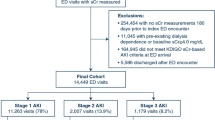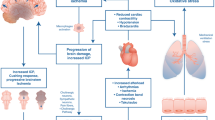Abstract
Introduction
With the advent of improved diagnostic and imaging techniques, it is now possible to detect renal cancers in their very early stages, when they are still present as small renal masses. In these situations, use of laparoscopic partial nephrectomy (LPN) techniques are indicated and have gained acceptance in major medical institutions worldwide, offering comparable oncological outcomes and improving quality of life in the patient when contrasted with open nephrectomy procedures. However, a complication that may occur during or after this surgery is the possibility of compromising renal function, as a result of extended ischemia times of more than 30 min. We have undertaken a systematic study of the potential of several agents that may enhance renal parenchymal preservation without causing unwanted renal dysfunction as a result of enhanced ischemia times. In this study, we have evaluated the potential of one such agent under study, namely hydralazine, which was shown earlier to enhance hypoxia inducible factor-1α (HIF-1α) levels in experimental animal systems. Our aim was to determine whether enhanced levels of HIF-1α via pre-treatment with hydralazine had a reno-protective effect after ischemic injury.
Materials and methods
Rats were injected with hydralazine or saline for 5 days prior to right nephrectomy and 40 min of cross-clamping of the left renal pedicle. Ischemic damage was monitored via serum chemistry and renal pathology.
Results
In our system, we found that hydralazine pre-treatment, even though it enhanced HIF-1α levels in the kidney, it also increased serum creatinine and worsened the morphological damage to the renal tubules in the ischemic kidney.
Conclusions
We conclude that even though this agent was described as a powerful inhibitor of prolyl hydroxylases, enhancing the levels of HIF-1α, it should be approached with caution when it is considered to enhance warm ischemia time and minimize the renal damage subsequent to LPN.





Similar content being viewed by others
Abbreviations
- LPN:
-
Laparoscopic partial nephrectomy
- HIF:
-
Hypoxia inducible factor
- PAS:
-
Periodic acid-Schiff
- SDS-PAGE:
-
Sodium dodecyl sulfate polyacrylamide gel electrophoresis
- PHD:
-
Prolyl hydroxylase
- BUN:
-
Blood urea nitrogen
References
Novick AC (2004) Laparoscopic partial nephrectomy. Clin Cancer Res 10:6322s–6327s
Porpiglia F, Renard J, Billia M, Musso F, Volpe A, Burruni R, Terrone C, Colla L, Piccoli G, Podio V, Scarpa RM (2007) Is warm ischemia over 30 minutes during laparoscopic partial nephrectomy possible? One year results of a prospective study. Eur Urol 52:1170–1178
Janetschek G (2007) Laparoscopic partial nephrectomy for RCC: how can we avoid ischemic damage of the renal parenchyma? Eur Urol 52:1303–1305
Pyo P, Chen A, Grasso M (2008) Retroperitoneal laparoscopic partial nephrectomy: surgical experience and outcomes. J Urol 180:1279–1283
Versteilen AM, DiMaggio F, Leemreis JR, Groeneveld AB, Musters RJ, Sipkema P (2004) Molecular mechanisms of acute renal failure following ischemia/reperfusion. Int J Artif Organs 27:1019–1029
Basile DP, Fredrich K, Alausa M, Vio CP, Liang M, Riede MR, Greene AS, Cowley AW Jr (2005) Identification of persistently altered gene expression in kidney following functional recovery from ischemic acute renal failure. Am J Physiol Renal Physiol 288:F253–F263
Nangaku M (2004) Mechanisms of tubulointerstitial injury in the kidney: final common pathways to end stage renal failure. Intern Med 43:9–17
Uzzo RG, Novick AC (2001) Nephron sparing surgery for renal tumors: indication, techniques and outcomes. J Urol 166:1264–1266
Pandanilam BJ (2003) Cell death induced by acute renal injury: a perspective of the contribution of apoptosis and necrosis. Am J Physiol Renal Physiol 284:F608–F627
Meldrum KK, Meldrum DR, Hile KL, Yerkes ES, Ayala A, Cain MP, Rink RC, Casale AJ, Kaeger MA (2001) p38 MAPK mediates renal tubular cell TNF-alpha production and TNF-alpha dependent apoptosis during simulated ischemia. Am J Physiol Cell Physiol 281:C563–C570
Semenza GL, Wang GL (1992) A nuclear factor induced by hypoxia via de novo protein synthesis binds to the human erythropoietin gene enhancer at a site required for transcriptional activation. Mol Cell Biol 12:5447–5454
Haase VH (2006) Hypoxia inducible factors in the kidney. Am J Physiol Renal Physiol 291:F271–F287
Wenger RH (2002) Cellular adaptation to hypoxia, O2 sensing protein hydroxylases, hypoxia inducible transcription factors and O2 regulated gene expression. FASEB J 16:1151–1162
Ivan M, Kondo K, Yang H, Kim W, Valiando J, Ohh M, Salic A, Asara JM, Lane WS, Kaelin WG Jr (2001) HIF-1α targeted for VHL mediated destruction by praline hydroxylation: implications for O2 sensing. Science 292:464–468
Jaakkola P, Mole DR, Tian Y-M, Wilson MI, Gielbert J, Gaskell SJ, von Kreigsheim A, Hebestreit HF, Mukerji M, Schofield CJ, Maxwell PH, Pugh CW, Ratcliffe PJ (2001) Targeting of HIF-1α to the von Hippel Lindau ubiquitylation complex by O2 regulated prolyl hydroxylation. Science 292:468–472
Shimizu H, Takahashi T, Suzuki T, Yamasaki A, Fujiwara T, Odaka Y, Hirakawa M, Fujita H, Akagi R (2000) Protective effect of heme oxygenase induction in ischemic acute renal failure. Crit Care Med 28:809–817
Sharples EJ, Patel N, Brown P, Stewart K, Mota-Philipe H, Sheaff M, Kieswich J, Allen D, Harwood S, Raftery M, Thiemermann C, Yaqoob MM (2004) Erythropoietin-1 protects the kidney against the injury and dysfunction caused by ischemia-reperfusion. J Am Soc Nephrol 15:2115–2124
Savino R, Ciliberto G (2004) A paradigm shift for erythropoietin: no longer a specialized growth factor, but an all-purpose tissue protective agent. Cell Death Differ 11(Suppl 1):S2–S4
Rosenberger C, Mandriota S, Jurgensen JS, Wiesener MS, Horstrup JH, Frei U, Ratclife PJ, Maxwell PH, Bachmann S, Eckardt K-U (2002) Expression of hypoxia inducible factor-1 α and hypoxia inducible factor 2 α in hypoxic and ischemic rat kidneys. J Am Soc Nephrol 13:1721–1732
Bonventre JV (2002) Kidney ischemic preconditioning. Curr Opin Nephrol Hypertens 11:43–48
Bernhardt WM, Campean V, Kany S, Jurgensen JS, Weidemann A, Warnecke C, Arend M, Klaus S, Gunzler V, Amann K, William C, Wiesener MS, Eckardt KU (2006) Preconditional activation of hypoxia inducible factors ameliorates ischemic acute renal Failure. J Am Soc Nephrol 17:1970–1978
Rosenberger C, Heyman SN, Rosen S, Shina A, Gioldfarb M, Griethe W, Frei U, Reinke P, Bachmann S, Eckardt KU (2005) Upregulation of HIF-Iα in experimental acute renal failure: evidence for a protective transcriptional response to hypoxia. Kidney Int 67:531–542
Weidemann A, Bernhardt WM, Klanke B, Daniel C, Buchholz B, Campean V, Amann K, Warnecke C, Wiesener MS, Wckradt KU, Willam C (2008) HIF activation protects from acute kidney injury. J Am Soc Nephrol 19:486–494
Matsumato M, Makino Y, Tanaka T, Ishizaka N, Noiri E, Fujita T, Nangaku M (2003) Induction of renoprotective gene expression by cobalt ameliorates ischemic injury of the kidney in rats. J Am Soc Nephrol 14:1825–1832
Bhatnagar RS, Papaka SSR, Liu TZ, Wolfe SM (1972) Hydralazine induced disturbances in collagen biosynthesis. Biochim Biophys Acta 271:125–132
Murad S, Tajima S, Pimnell SR (1985) A paradoxical effect of hydralazine on prolyl and lysyl hydroxylase activities in cultured human skin fibroblasts. Arch Biochem Biophys 241:356–363
Knowles HJ, Tian Y-M, Mole DR, Harris AL (2004) Novel mechanism of action for hydralazine: Induction of hypoxia inducible factor-1 α, vascular endothelial growth factor and angiogenesis by inhibition of prolyl hydroxylases. Circ Res 95:162–169
Gogia H, Mehra A, Parikh S, Raman M, Ajit-Uppal J, Johnson JV, Elkayam U (1995) Prevention of tolerance to hemodynamic effects of nitrates with concomitant use of hydralazine in patients with chronic heart failure. J Am Coll Cardiol 26:1575–1580
Atlas SA (2007) The renin-angiotensin aldosterone system: pathophysiological role and pharmacologic inhibition. J Manag Care Pharm 13(Suppl B):S9–S20
Haugen EN, Croatt AJ, Nath KA (2000) Angiotensin II induces renal oxidant stress in vivo and heme oxygenase-1 in vivo and in vitro. Kidney Int 58:144–152
Izuhara Y, Nangaku M, Inagi R, Tominaga N, Aizawa T, Kurokawa K, de Strihou C, Miyata T (2005) Renoprotective properties of angiotensin receptor blockers beyond blood pressure lowering. J Am Soc Nephrol 16:3631–3641
Acknowledgments
This work was supported in part by the Susan Schott Memorial Fund and the Department of Urology, Saint Vincent Medical Center.
Conflict of interest statement
There is no conflict of interest.
Author information
Authors and Affiliations
Corresponding authors
Rights and permissions
About this article
Cite this article
Michels, C., Dorai, T., Chander, P. et al. Hypoxic pre-conditioning in a rat renal ischemia model: an evaluation of the use of hydralazine. World J Urol 27, 817–823 (2009). https://doi.org/10.1007/s00345-009-0415-z
Received:
Accepted:
Published:
Issue Date:
DOI: https://doi.org/10.1007/s00345-009-0415-z




